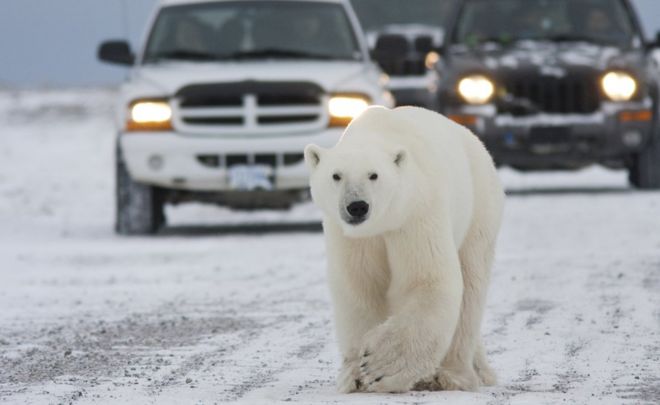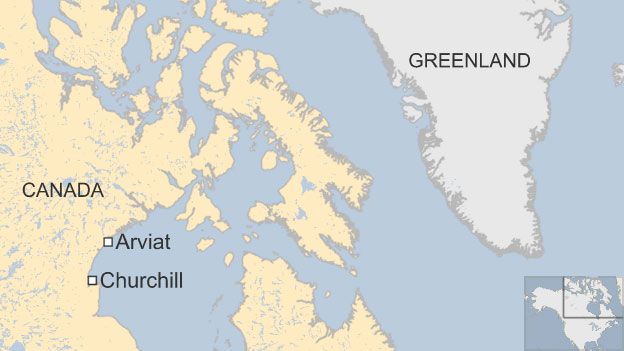For 15 years, Irish anthropologist Martina Tyrrell has studied the relationship between humans and animals in Arviat, an Inuit community on the west coast of Hudson Bay, where the townspeople are increasingly having to cope with a large and dangerous visitor - the polar bear.

People and polar bears have always lived side-by-side in this part of the world but in the past it was rare for bears to enter the town. Now, every summer and autumn, it's becoming an uncomfortable part of everyday life.

Polar bears tower over humans, sometimes measuring as much as 12 feet from nose to tail. But Inuit believe that humans and bears have much in common. When bears rear up on their hind legs to sniff the air, to play, to attack or defend themselves, they resemble two-legged humans. And like Inuit, bears are at home on both sea ice and land. At sea they hunt the same marine mammal species for sustenance - humans and bears are rival predators at the top of the food chain.

Polar bears: Key facts
- Polar bears are the biggest land-based carnivores in the world and live in the Arctic;
- They mainly eat seals, which they detect using their remarkable sense of smell - bears can smell a seal in the water beneath a metre of compacted snow, and on land from almost 1km (0.6 miles) away:
- Climate change is currently the single greatest threat to polar bears - their icy habitat is melting away
Source: WWF
Over the past decade, however, encounters have been on the increase. Camping south of the community in summer is no longer safe, and autumn berry picking - an important subsistence activity usually undertaken by women and children - is now fraught with danger. Bears increasingly wander the streets of Arviat, particularly in late autumn.
At this time of year, regular announcements of bear sightings are made on local community FM radio, schools are sometimes closed early and the usually lively streets are eerily quiet. Halloween trick-or-treating, once so wild and fun-filled, has been all but wiped out, for fear of unwanted encounters not with ghosts or demons but with wandering bears.
What is driving this change in the polar bears' behaviour?
Many Arviarmiut blame polar bear tourism in neighbouring Churchill - 250km to the south - for encouraging the animals to look for food in human settlements.

But there are other theories. Some Inuit think the bear population in the region is growing. Many scientists, on the other hand, put the blame on habitat loss - according to this theory it's the desperation of hungry bears facing decreased ice seasons in a rapidly warming Arctic that leads them to approach the town. They have always gathered on the coastline at this time of year, awaiting the formation of the sea ice that is their winter hunting ground, but usually at a greater distance.
Whatever the cause, Arviarmiut have had to get used to sharing their community with growing numbers of large, dangerous and unpredictable carnivores. Many towns in the northern Canadian territory of Nunavut are in the same position - Clyde River, Hall Beach and Resolute Bay have all reported problems in the past couple of years.
In Arviat, things reached a critical point four years ago.
Between 2010 and 2011, 11 polar bears were killed by Arviarmiut defending life or property. So, in 2011, with financial support from WWF (Canada), local hunter Leo Ikakhik was hired as a full-time polar bear monitor. Leo patrols the town, responds to sightings, and discourages polar bears through the use of spotlights and bangers. In addition, many homes have been provided with sealed steel bins for storing frozen meat, which was previously stored on roofs in sub-zero temperatures, and electric fences have been erected around sled dog teams. As a result of these measures, defence kills have all but ceased.
But a number of bears are also killed each year by hunters.
Adapted from BBC News. Magazine
